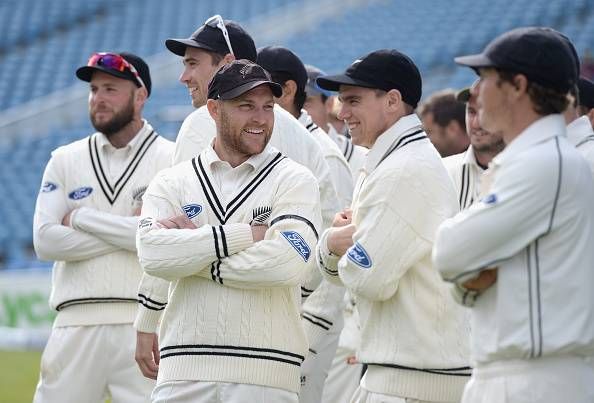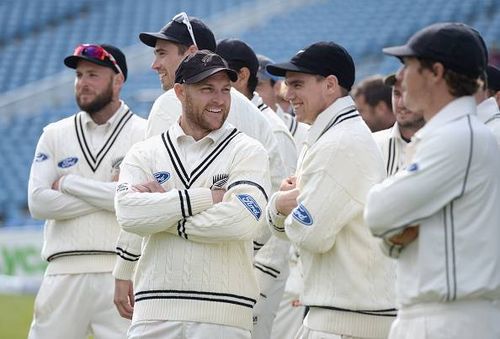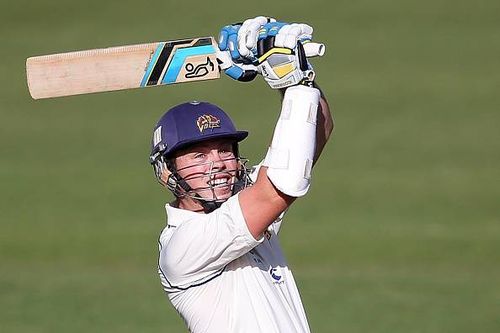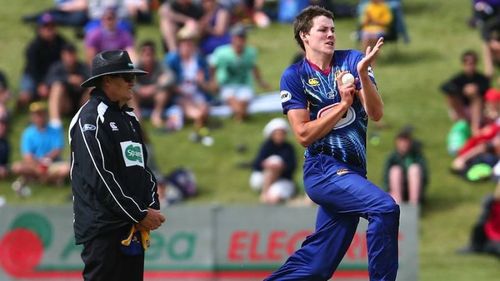
Can New Zealand continue ascent to become best side in the world?

Not very long ago, New Zealand were shot out for 45 in a Test match against South Africa in Cape Town - their lowest Test total since 1974. The chasm between the two sides was extremely wide and gave the impression of an utter mismatch. New Zealand seemed like they were going round and round in circles, not learning from their previous mistakes. They huffed and puffed as the world around went past them at a breathtaking pace. Something had to be done to stem the rot.
Fast forward to the present. New Zealand look a completely different outfit altogether. In the recent World Cup where they were the runners-up, they carried out an all-out assault against all oppositions. While it worked wonders for them, there were moments when the strategy backfired leaving them high and dry. But they didn’t curb their style; they chose to persist with it and eventually won all games but the final.
That’s New Zealand for you - unflinching in the face of challenge, unrelenting in their technique and above all a force to reckon with. Their meteoric rise in international cricket can be attributed to the success of the unit as a whole and the immense belief they have in one another’s abilities. From a distant outsider just a couple of years ago, New Zealand have now become everybody’s favourite side and are poised to usher in a new era in the game of cricket.
While there is no doubt that the Black Caps are redefining the game of cricket with their aggressive outlook across all formats, thereby leaving spectators spellbound, the question now is whether they can go on to achieve unparalleled success and become the No.1 team across all formats.
In an exclusive interview with The Telegraph, New Zealand skipper Brendon McCullum spoke at length about his team’s fresh outlook and the recent success. Not one to mince his words, McCullum emphasised on how putting their heart and soul into the sport has helped his side overcome many challenges. Leading a group of fiercely talented players, McCullum feels that the key to success lies in playing aggressively without worrying about the results. Such a carefree attitude helps players express themselves and instils faith in the entire side. Victory will follow suit.
What I have liked best about this current New Zealand side, apart from the fact that they keep you literally on the edge of your seat, is that they have always tried to remain true to their style, which is going all out on the opposition at all times. There’s no room for passivity in their game which makes it even more fun to watch.
As a captain, McCullum leads by example. He has become the pivot around which the fortunes of his team revolve. He may not be New Zealand’s most reliable batsman but surely is the most valuable player who provides a cushion to the rest of the players. He puts fielders in unconventional positions, occasionally bowls out his main bowlers inside the first 30 overs in ODI cricket and swings through the line when he’s batting no matter how precarious the situation may be. McCullum is a force. He attacks and everyone else follows.
Then you have a pool of batsmen rooted in anything but orthodoxy. Their craft comes with an aura of brashness. Even with their backs firmly to the walls, they don’t give up on their attacking instincts, always staying a step ahead of the opposition. They play at breakneck speed – speed that’s unfathomable at times and extremely hard to emulate.
And then there are the fast bowlers, who with their vicious swing and ferocious pace test the batsmen – almost coercing them to make mistakes. The spinners spin a web around the batsmen with fielders sniffing around the stumps waiting for the ball to come to them.
There’s depth in this side, they stick to a plan and are committed to the cause even when the game is slipping away from them. In this lies the crux to New Zealand’s chances of becoming the best side in the world. The prospects of it are eye-catching, but whether they can sustain themselves or not is what remains to be seen. However, here are certain things that New Zealand could do to ensure that they get there in the near future.
Have a plan B
In the World Cup final earlier this year, New Zealand were found wanting due to the lack of a backup plan. Eventually, they ran out of aggression and were beaten comprehensively by an Australian side that played better cricket on the given day. McCullum and his men work under the impression that attack is the best form of defence and while this swashbuckling method is delightful to watch, it can backfire when the situation isn’t right.
Setting the pace is fine but by doing that, there’s a risk of going too far ahead of the game, so much so that you lose control of the proceedings. Hence, it is imperative that they have a backup plan to bail the side out of rough waters – a more level-headed approach where a couple of batsmen will anchor the scoring as others come and bat around them.
Not only will that lend more stability to the side but will render flexibility to the options they have at hand. This is not to say that they must do away with their heady brand of aggressive cricket; only that they will do well to incorporate the other facets of batting so that when pressure is high, they don’t get vulnerable to rash thoughts.
Horses for courses
Trent Boult and Tim Southee have been destructive with the new ball, blending pace with swing. But they looked completely out of their depth in the recent IPL when batsmen hit them all around the park on those dry and flat Indian pitches. While New Zealand seem to have found the right bowling combination for conditions that aid swing and seam movement, they still lack the resources to take 20 wickets in a Test match on the dead sub-continent pitches where there’s barely any movement off the wicket or in the air.
While McClenaghan and Matt Henry seem to have resolved New Zealand’s problems of a third seamer for now, there’s plenty of work to be done when it comes to suiting their styles for all kinds of surfaces. Also, in the post Daniel Vettori era, their spinning options have looked quite thin. While it’s difficult to replace Vettori, they ought to nurture a host of spinners who can both attack and defend. The likes of Mark Craig and Mitchell Santner have earned their chances to play for New Zealand and now might be a really good time to train them for the wear and tear of international cricket.
Bring reliability in the batting
All those thunderous finishes will amount to nothing if the batsmen can’t hold fort when the tide is against them. Their batting can be found wanting in tough situations and except for Kane Williamson, who is poised to shatter all New Zealand batting records, every other batsman has looked susceptible at some point or the other.
Captain McCullum must show some restraint and not brandish his willow at every ball. With a player of his class and power, New Zealand would gain much more if he stays at the crease for a longer duration instead of getting out after brief cameos. Ross Taylor is a world-class batsman, highly motivated even but he too needs to adjust his game now to meet the demands of a changing New Zealand side.
Martin Guptill has shown in the past that he can bat deep into the innings and with fluent footwork and a tight technique, he should try and become New Zealand’s go-to man in times of trouble. Then there’s Corey Anderson, Grant Elliott and Luke Ronchi; all extremely resourceful and genuine match-winners in the shorter version, but they have to turn into steadfast options in the five-day game as well if New Zealand are to make it to the top of the rankings in both formats.
Players to watch out for
If New Zealand want to climb up the ladder, they ought to start looking at other options as well as it is almost impossible to have your first-choice XI on the park at all times. Here’s a list of 5 players from domestic cricket who can prove to be valuable backups in case of a loss of form or injury to one of the main players.
Michael Bracewell
Team: Otago

A left-hand, top-order wicketkeeper batsman from Otago, Michael Bracewell was named in New Zealand’s squad for the Under-19 World Cup in 2010. He shot to prominence as a 19-year old bludgeoning 151 off 136 balls which included 17 fours and five sixes to guide his club to the 2010 National Club Finals.
Statistics
|
Format |
Matches |
Runs |
HS |
Average |
No. of centuries |
No. of half-centuries |
|---|---|---|---|---|---|---|
|
First-Class |
42 |
2732 |
190 |
40.17 |
7 |
10 |
|
List A |
46 |
1167 |
106 |
28.46 |
1 |
7 |
Henry Nicholls
Team: Canterbury
Canterbury batsman Henry Nicholls just recently scored his second first-class century, against Auckland, capping off a wonderful season in which he also scored his debut first-class century and his first hundred in limited-overs cricket.
Statistics
|
Format |
Matches |
Runs |
HS |
Average |
No. of centuries |
No. of half-centuries |
|---|---|---|---|---|---|---|
|
First-Class |
32 |
1852 |
119 |
33.67 |
2 |
12 |
|
List A |
30 |
977 |
178 |
40.70 |
1 |
7 |
Michael Pollard
Team: Wellington
Right-handed batsman Michael Pollard was recently in the news for scoring a mammoth 153 of 132 balls that helped New Zealand Board President’s XI beat a touring Pakistani side. His innings included 16 fours and three sixes as he nicely shepherded a run chase of 269. Known for his hard-hitting skills, Pollard’s runs have been coming in decent clusters in the past few seasons and if he continues his good form, a New Zealand cap may be round the corner.
Statistics
|
Format |
Matches |
Runs |
HS |
Average |
No. of centuries |
No. of half-centuries |
|---|---|---|---|---|---|---|
|
First-Class |
34 |
1786 |
166 |
29.76 |
3 |
8 |
|
List A |
27 |
916 |
114 |
35.23 |
1 |
6 |
Jacob Duffy
Team: Otago

This right-arm fast bowler has already taken a tentative step into international cricket as he travelled with the current New Zealand team in the build-up to the Test series against England. Acting as a cover for players who had not arrived from the IPL, Duffy’s call came on the back of an excellent outing in the Plunket Shield where he took 45 wickets at an average of 24.06. Duffy is one of two fast bowlers New Zealand are looking to nurture through such warm-up games. The other is Central Districts left-armer Ben Wheeler.
Statistics
|
Format |
Matches |
Wickets |
Average |
Economy |
4W |
5W |
|---|---|---|---|---|---|---|
|
First-Class |
22 |
65 |
32.26 |
3.13 |
1 |
3 |
|
List A |
15 |
23 |
29.78 |
6.04 |
1 |
1 |
Seth Rance
Team: Central Districts
An all-rounder from Wellington, Seth Rance showed a lot of promise in his first full domestic season with the Central Districts. He was instrumental in his side’s victory in the HRV Cup, the domestic T20 tournament, where he took 11 wickets from 6 matches at an economy rate of 6.37. His two first-class fifties and a strike rate of above 90 suggest that he has got a fair bit of flair for batting as well.
Statistics
|
Format |
Matches |
Wickets |
Average |
Economy |
4W |
5W |
|---|---|---|---|---|---|---|
|
First-Class |
17 |
35 |
48.08 |
3.33 |
1 |
1 |
|
List A |
16 |
27 |
25.77 |
5.45 |
1 |
0 |
A quick glance at the domestic numbers would suggest that while New Zealand does have some promising talents, it will take them some time to raise the bar and play for the national side. In the meanwhile, it is important that New Zealand Cricket (NZC) keeps an eye out for such budding cricketers and gives them the required guidance so that they remain in the loop and don’t go astray.
Statistics are of course an important yardstick to measure the success of a side, but to many, the heart of a team’s success lies in the manner that they play the game and what those performances mean to the team. In this regard, New Zealand are clearly head and shoulders above their contemporaries.
But like it or not, numbers matter just as much as emotions in this wonderful sport and New Zealand would have to keep racking up those wins on their way to the top. A clear mind and a belief that they can beat the best is what has brought McCullum’s New Zealand success so far and there is no reason why they shouldn’t reach the very top if they continue this way.
Suffice to say, the Kiwis have finally learnt to fly.